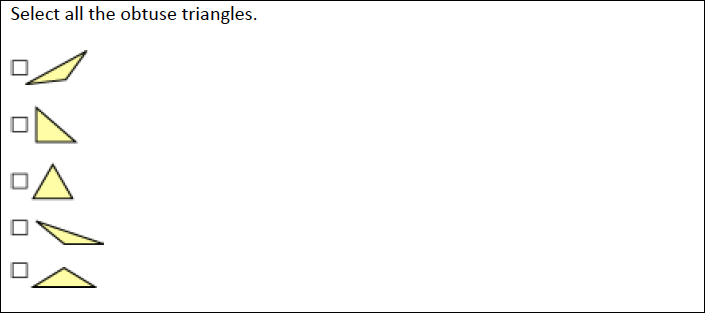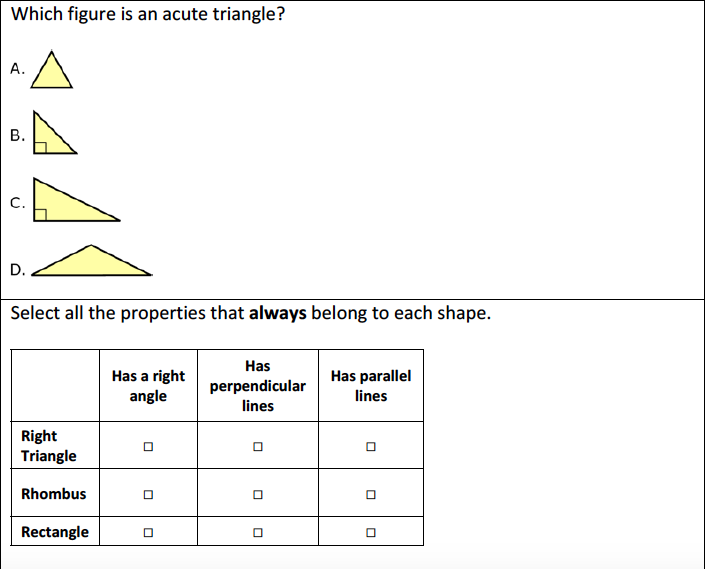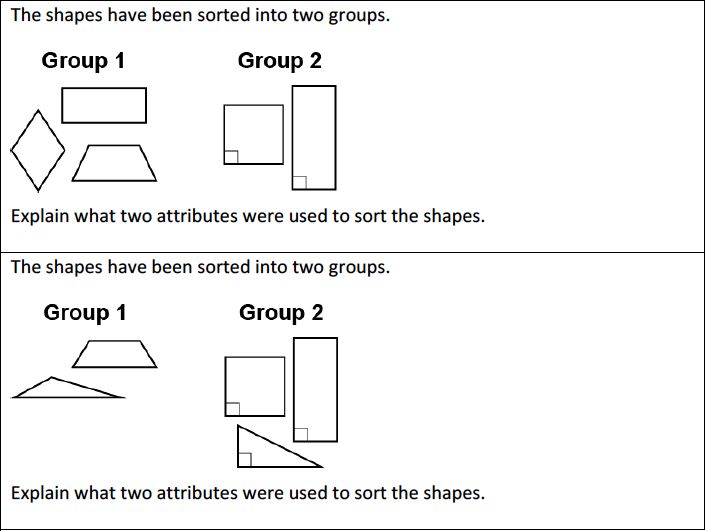Classify two-dimensional figures based on the presence or absence of parallel or perpendicular lines, or the presence or absence of angles of a specified size. Recognize right triangles as a category, and identify right triangles.
[divider] [/divider]Students are able to…
- Recognize two dimensional shapes have specific attributes of angles, parallel and perpendicular lines.
- Apply understanding of attributes to triangles and use attributes to describe the differences in triangles.
- Categorize quadrilaterals based on side size, angles size and the presence of parallel or perpendicular lines.
[divider] [/divider]Students are able to…because teachers:
- Provide tasks that allow students to sort two-dimensional shapes in multiple ways based on attributes.
- Plan experiences that utilize charts and diagrams when sorting shapes and identifying attributes.
- Ask purposeful questions that allow students to develop generalizations about two dimensional shapes.
[divider] [/divider]Questions to ask students:
- Draw a rectangle. Iidentify the attributes that make it a rectangle.
- Sample answer that indicates understanding: This shape has two sets of parallel sides and two sets of perpendicular lines. It also has 4 right angles. Opposite sides of the shape are the same length.
- Sample answer that indicates an incomplete understanding or a misconception: This shape has four sides and the opposite sides are the same length, but the length and width are different.
- Draw a right triangle. Can you draw a triangle with two right angles? Can you draw a triangle with two obtuse angles? Why or why not?
- Sample answer that indicates understanding: That shape can’t be drawn. If I already have a right angle the other two angles must be acute to close the shape and only use three sides.
- Sort your shapes by the types of angles. How did you know your right trapezoid could fit in all the groups?
- Sample answer that indicates understanding: The right trapezoid has 2 right angles, 1 obtuse angle and 1 acute angle.
- Draw a quadrilateral with two sets of parallel lines.
- Sample answer that indicates understanding: Students draw any parallelogram: parallelogram, rhombus, rectangle or square.
[divider] [/divider]FSA Notes
Cognitive Complexity Level: 2 – Basic Application of Skills and Concepts
Achievement Level Descriptors:
2- identifies two-dimensional figures
3– classifies two-dimensional figures based on the presence or absence of parallel or perpendicular lines, or the presence or absence of angles of specified size; identifies right triangles
4- constructs two-dimensional figures based on the presence or absence of parallel or perpendicular lines, or the presence or absence of angles of specified size
5– analyzes and justifies how groups of two-dimensional figures are sorted based on the presence or absence of parallel or perpendicular lines, or the presence or absence of angles of specified size
Assessment Limits:
Triangles: equilateral, equiangular, isosceles, scalene, acute, right, obtuse.
Quadrilaterals: parallelograms, rectangles, squares, rhombi, trapezoids.
Other polygons may be included where appropriate.
Items that include trapezoids must consider both the inclusive and exclusive definitions.
Items may not use the term “kite” but may include the figure.
Context: No context
[divider] [/divider]
Additional Resources:
Additional in depth content knowledge
Video: Classify triangles by examining their properties
[divider] [/divider]Sample Formative Assessment Tasks:
[divider] [/divider] Resources and Tasks To Support Your Child at Home
Have your child look at triangles and quadrilaterals. Name them based on their attributes of side types/lengths and angles.
Play Pictionary with the polygon, quadrilateral or triangle names.
Give your child a shape riddle or definition of the triangle or quadrilateral and have them draw the shape.
Khan Academy: Classifying Shapes by Lines and Angles
Khan Academy: Classifying Triangles
Khan Academy: Quadrilateral Properties
NCTM Illuminations Shape Sorter



